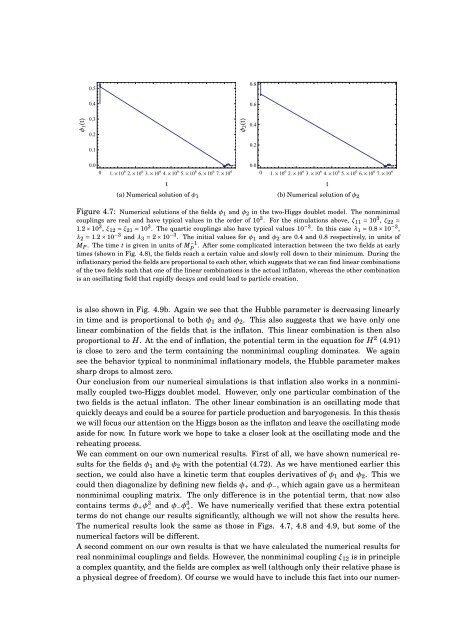Master's Thesis in Theoretical Physics - Universiteit Utrecht
Master's Thesis in Theoretical Physics - Universiteit Utrecht
Master's Thesis in Theoretical Physics - Universiteit Utrecht
You also want an ePaper? Increase the reach of your titles
YUMPU automatically turns print PDFs into web optimized ePapers that Google loves.
0.50.80.40.6Φ1t0.30.20.1Φ2t0.40.20.00 1. 10 6 2. 10 6 3. 10 6 4. 10 6 5. 10 6 6. 10 6 7. 10 60.0(a) Numerical solution of φ 1 (b) Numerical solution of φ 20 1. 10 6 2. 10 6 3. 10 6 4. 10 6 5. 10 6 6. 10 6 7. 10 6ttFigure 4.7: Numerical solutions of the fields φ 1 and φ 2 <strong>in</strong> the two-Higgs doublet model. The nonm<strong>in</strong>imalcoupl<strong>in</strong>gs are real and have typical values <strong>in</strong> the order of 10 3 . For the simulations above, ξ 11 = 10 3 , ξ 22 =1.2 × 10 3 , ξ 12 = ξ 21 = 10 3 . The quartic coupl<strong>in</strong>gs also have typical values 10 −3 . In this case λ 1 = 0.8 × 10 −3 ,λ 2 = 1.2 × 10 −3 and λ 3 = 2 × 10 −3 . The <strong>in</strong>itial values for φ 1 and φ 2 are 0.4 and 0.8 respectively, <strong>in</strong> units ofM P . The time t is given <strong>in</strong> units of MP −1 . After some complicated <strong>in</strong>teraction between the two fields at earlytimes (shown <strong>in</strong> Fig. 4.8), the fields reach a certa<strong>in</strong> value and slowly roll down to their m<strong>in</strong>imum. Dur<strong>in</strong>g the<strong>in</strong>flationary period the fields are proportional to each other, which suggests that we can f<strong>in</strong>d l<strong>in</strong>ear comb<strong>in</strong>ationsof the two fields such that one of the l<strong>in</strong>ear comb<strong>in</strong>ations is the actual <strong>in</strong>flaton, whereas the other comb<strong>in</strong>ationis an oscillat<strong>in</strong>g field that rapidly decays and could lead to particle creation.is also shown <strong>in</strong> Fig. 4.9b. Aga<strong>in</strong> we see that the Hubble parameter is decreas<strong>in</strong>g l<strong>in</strong>early<strong>in</strong> time and is proportional to both φ 1 and φ 2 . This also suggests that we have only onel<strong>in</strong>ear comb<strong>in</strong>ation of the fields that is the <strong>in</strong>flaton. This l<strong>in</strong>ear comb<strong>in</strong>ation is then alsoproportional to H. At the end of <strong>in</strong>flation, the potential term <strong>in</strong> the equation for H 2 (4.91)is close to zero and the term conta<strong>in</strong><strong>in</strong>g the nonm<strong>in</strong>imal coupl<strong>in</strong>g dom<strong>in</strong>ates. We aga<strong>in</strong>see the behavior typical to nonm<strong>in</strong>imal <strong>in</strong>flationary models, the Hubble parameter makessharp drops to almost zero.Our conclusion from our numerical simulations is that <strong>in</strong>flation also works <strong>in</strong> a nonm<strong>in</strong>imallycoupled two-Higgs doublet model. However, only one particular comb<strong>in</strong>ation of thetwo fields is the actual <strong>in</strong>flaton. The other l<strong>in</strong>ear comb<strong>in</strong>ation is an oscillat<strong>in</strong>g mode thatquickly decays and could be a source for particle production and baryogenesis. In this thesiswe will focus our attention on the Higgs boson as the <strong>in</strong>flaton and leave the oscillat<strong>in</strong>g modeaside for now. In future work we hope to take a closer look at the oscillat<strong>in</strong>g mode and thereheat<strong>in</strong>g process.We can comment on our own numerical results. First of all, we have shown numerical resultsfor the fields φ 1 and φ 2 with the potential (4.72). As we have mentioned earlier thissection, we could also have a k<strong>in</strong>etic term that couples derivatives of φ 1 and φ 2 . This wecould then diagonalize by def<strong>in</strong><strong>in</strong>g new fields φ + and φ − , which aga<strong>in</strong> gave us a hermiteannonm<strong>in</strong>imal coupl<strong>in</strong>g matrix. The only difference is <strong>in</strong> the potential term, that now alsoconta<strong>in</strong>s terms φ + φ 3 − and φ −φ 3 + . We have numerically verified that these extra potentialterms do not change our results significantly, although we will not show the results here.The numerical results look the same as those <strong>in</strong> Figs. 4.7, 4.8 and 4.9, but some of thenumerical factors will be different.A second comment on our own results is that we have calculated the numerical results forreal nonm<strong>in</strong>imal coupl<strong>in</strong>gs and fields. However, the nonm<strong>in</strong>imal coupl<strong>in</strong>g ξ 12 is <strong>in</strong> pr<strong>in</strong>ciplea complex quantity, and the fields are complex as well (although only their relative phase isa physical degree of freedom). Of course we would have to <strong>in</strong>clude this fact <strong>in</strong>to our numer-
















